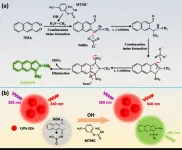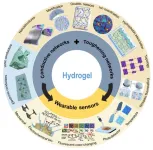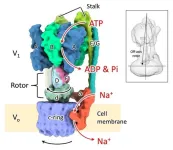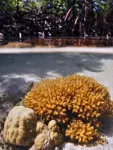(Press-News.org)
Now that the world has experienced its hottest day in history, it is more urgent than ever for natural and social scientists to work together to address the climate crisis and keep global temperature increases below 2°C. To this end, an international group of esteemed researchers recently published an innovative research paper that highlights the importance of integrating knowledge from natural and social sciences to inform about effective climate change policies and practice. They argue that the concept of tipping points can serve as a bridge between these fields of study, facilitating a comprehensive understanding of climate change processes and impacts.
The group, led by the Institute of Environmental Science and Technology at the Universitat Autònoma de Barcelona (ICTA-UAB), includes researchers from other scientific institutions in Australia, Italy, Spain, France, Germany, and Portugal. The team is composed of Sonia Graham, Melanie Wary, Fulvia Calcagni, Mercè Cisneros, Claudia De Luca, Santiago Gorostiza, Ola Stedje Hanserud, Giorgos Kallis, Panagiota Kotsila, Sina Leipold, Jagoba Malumbres-Olarte, Tristan Partridge, Anna Petit-Boix, Anke Schaffartzik, Galia Shokry, Sergio Tirado-Herrero, Jeroen van den Bergh, and Patrizia Ziveri.
Traditionally, natural scientists have focused on documenting and analyzing changes in the natural environment, such as rising global temperatures, altered rainfall patterns, and extreme weather events. More recently, natural scientists have questioned whether the changes we are witnessing are reversible and if there is a tipping point at which, no matter how much we curb our greenhouse gas emissions, the environmental changes will be permanent.
However, the research team asserts that these environmental considerations must be accompanied by an exploration of social dynamics, encompassing individual, collective, and societal behaviors. To ensure a sustainable future, it is imperative to comprehend the intricate interaction between environmental and social changes.
The researchers pose critical questions: Who benefits from and contributes the most to the current trajectory? What alternative and desirable scenarios exist, and how can we intentionally work towards them? Are there social tipping points that could help us rapidly change our practices, norms, and institutions towards those scenarios?
To show the value of studying social and climate tipping points together, the team focuses on the climate change-induced slowdown of the Atlantic Ocean currents, which resulted in the devastating flooding of the Ahr Valley, in Germany. Through this example, they demonstrate how extreme weather events impact local communities and how these communities adapt their ways of life to cope with future extreme events. The integrated analysis of environmental and social changes allows for an understanding of the complex interaction between climate change and society and enables the assessment of whether our responses benefit everyone, or only a few. Furthermore, it allows for the evaluation of the consequences of human responses at different scales, whether local, national, or international.
The researchers assert that by fostering collaboration between natural and social scientists, the collective capacity to address the climate crisis is enhanced. Their work underscores the critical need for a multidisciplinary approach that combines knowledge from both fields to develop comprehensive solutions and shape sustainable policies for a better future.
END
Recently, Prof. JIANG Changlong and his research team at the Institute of Solid State Physics, Hefei Institutes of Physical Science (HFIPS) of Chinese Academy of Sciences (CAS), developed and synthesized two highly effective ratiometric fluorescence nanoprobes. These nanoprobes, when combined with the color recognition capabilities of smartphones, enabled the visual and quantitative detection of pesticides in food and environmental water.
The research has been published in Chemical Engineering Journal and ACS Sustainable Chemistry & Engineering.
Carbamate compounds ...
Scientists have found a way to use nanotechnology to create a 3D ‘scaffold’ to grow cells from the retina –paving the way for potential new ways of treating a common cause of blindness.
Researchers, led by Professor Barbara Pierscionek from Anglia Ruskin University (ARU), have been working on a way to successfully grow retinal pigment epithelial (RPE) cells that stay healthy and viable for up to 150 days. RPE cells sit just outside the neural part of the retina and, when damaged, can cause vision to deteriorate.
It ...
This review is written by Dr. Weixing Song from the Department of Chemistry, Capital Normal University. The paper reviewed the toughness and conductive network of existing hydrogel sensors. It emphasized the development status of various hydrogel sensors and highlighted strategies to enhance their mechanical and electrical performance. The findings are valuable for designing components and structures of high-performance wearable hydrogel sensors.
The increasing demand for healthcare IoT devices drives the development of wearable electronics. Electronic skins possess softness, stretchability, and self-healing ...
New Alzheimer’s research from UVA Health suggests that enhanced light sensitivity may contribute to “sundowning” – the worsening of symptoms late in the day – and spur sleep disruptions thought to contribute to the disease’s progression.
The new insights into the disruptions of the biological clock seen in Alzheimer’s could have important potential both for the development of treatments and for symptom management, the researchers say. For example, caregivers often struggle with the erratic sleep patterns caused by Alzheimer’s ...
Introduced in 2004, high-entropy alloys (HEAs) are alloys composed of multiple principal elements in nearly equiatomic proportions. Their unique chemical composition results in a high degree of chemical disorder, i.e. entropy, and produces remarkable properties such as high strength, ductility, and strong wear-and-tear resistance even at high temperatures. Scientists have dedicated a significant amount of attention to developing novel HEAs to help improve the performance of various electrocatalyst materials.
Because they are made up of differing constituent elements, HEAs' atomic-level surface designs can be complex. But unravelling this complexity is crucial, since the surface ...
San Diego, CA - The NEC Society and Cincinnati Children’s have teamed up to present the NEC Symposium, the only conference in North America dedicated to understanding and preventing necrotizing enterocolitis (NEC). NEC is a devastating intestinal disease that affects medically fragile infants in their first weeks and months of life. Every year in the United States, thousands of babies are diagnosed with NEC and at least one baby dies from NEC every day. The NEC Symposium will transform the NEC Research ...
North Carolina State University researchers recently found that a program designed to get Girl Scouts involved in citizen science – programs where members of the public can participate in real scientific research – not only taught girls about the process of science, but also motivated them to tackle scientific or environmental problems in their communities.
The findings demonstrate the impacts citizen science projects can have on their participants and offer lessons for other organizations on how to structure STEM-focused learning opportunities using citizen science.
“We’ve found that after participating ...
Six structures exhibited by the rotating sodium ion pump were reconstructed in 3D using cryo-electron microscopy. This analysis revealed that (1) the rotor exhibits non-uniform rotation behavior due to partial structural interference with the stator component, and (2) the rotor interacts with one edge of the large ion transport ring causing it to rotate. The study showed a unique molecular mechanism of the rotary sodium ion pump.
The results will be published on July 28 in Communications Biology.
“In previous single-molecule imaging ...
Resilient corals, often referred to as ‘super corals’, have recently been seen as potential saviours in the face of climate change and its detrimental effects on coral reefs.
Now, a team of scientists from the University of Technology Sydney (UTS) and the University of Haifa, Israel is working to better understand these corals in order to develop strategies to protect fragile ecosystems such as the Great Barrier Reef.
UTS scientist Dr Emma Camp, co-lead researcher on the study recently published in the journal Nature Communications, says the findings have significant implications ...
Infants who nap a lot have smaller vocabularies and poorer cognitive skills – according to new research from the University of East Anglia.
Parents the world over are prone to worry about their children getting either too little or too much sleep.
But a new study published today reveals that some children are more efficient at consolidating information during sleep, so they nap less frequently.
Meanwhile others, usually those with fewer words and poorer cognitive skills, need to nap more frequently.
The research team say that reducing naps for these children will not improve brain development, ...






